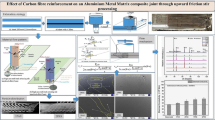Abstract
In recent years, research has been undertaken on manufacturing of functionally graded materials (FGM) using layered manufacturing technologies (LMT), also commonly known as rapid prototyping (RP), solid free-form fabrication (SFF) etc. The use of LMT to build complex FGM parts could meet optimum engineering design for various applications such as high performance die casting tools. In this context, H13 tool steel is considered a suitable material because of the high resistance to thermal fatigue and dimensional stability. Nevertheless, H13 with a low heat conduction coefficient is not thermally efficient for certain part geometries. With this in mind, the use of functionally graded techniques to disperse copper to specific regions/volumes of a H13 mould could lead to higher performance of the tool. The laser fusion of different proportions of Cu (0, 25 and 50% by weight) powder dispersed in H13 were analysed in this work. Additionally, different laser strategies were used to statistically analyse effects with respect to the composition of Cu. It was found that the refill strategy produces better results compared to all other scanning methods. The H13 with 25% Cu mix produced a homogeneous structure but cracks were observed along the cross section of the 25% Cu specimens. The pure H13 had a lower porosity with fine dendrite structures. The H13 with 50% Cu produced a non-homogeneous structure. This paper also discusses the microhardness tests results with respect to Cu composition and scanning strategy. Also, in order to identify the effect of powder composition layer on the subsequent layers and the cooling rate effect, samples were produced and analysed. One started with 100% H13 and ended with H13+50% Cu while the other started with H13+50% Cu and ended with 100% H13.
Similar content being viewed by others
References
Wohlers T (2004) Wohlers Report 2004. Wohlers Associates, Inc., USA, ISBN 0975442902
Suresh S, Mortensen A (1998) Fundamentals of functionally graded materials. Institute of Materials, London, ISBN 1-86125-063-0
Norton RL (1996) Machine design: an integrated approach. Prentice-Hall, New Jersey, ISBN 0-13-555475-6
Smith WF (1993) Structure and properties of engineering alloys, 2nd edn. McGraw-Hill, New York, ISBN 007591725
Menges G, Mohren P (1993) How to make injection molds, 2nd edn. Hanser, Munich, Germany, ISBN 1569902828
Su W (2002) Layered fabrication of tool steel and functionally graded materials with a Nd:YAG pulsed laser. PhD Thesis, Loughborough University, Loughborough, UK
Beal VE, Erasenthiran P, Hopkinson N, Dickens P, Ahrens, CH (2004) Fabrication of x-graded H13 and Cu powder mix using high power pulsed Nd:YAG laser. In: Proceedings of Solid Freeform Fabrication Symposium, 2–4 August, Austin, TX, USA
Storch S, Nelessen D, Shaefer G, Reiter R (2003) Selective laser sintering: qualifying analysis of metal based powder systems for automotive applications. Rapid Prototyping J 9(4):240–251
Atwood C, Griffith LH, Schlienger E, Ensz M, Smugeresky J, Romero T, Greene D, Reckaway D (1998) Laser engineering net shaping (LENS™): a tool for direct fabrication of metal parts. In: Proceedings of ICALEO ‘98, 16–19 November 1998, Orlando, FL, USA, pp E1–E7
Ensz MT, Griffith ML, Reckaway DE (2002) Critical issues for functionally graded material deposition by Laser Engineered Net Shaping (LENS™). In: Proceedings of the 2002 International Conference on Metal Powder Deposition for Rapid Manufacturing, 8–10 April, San Antonio, TX, USA, pp 195–202
Lu L, Fuh J, Wong YS (2001) Laser-induced materials and processes for rapid prototyping. Kluwer Academic, Norwell, ISBN 0792374002
Morgan R, Sutcliffe CJ, O’Neill W (2001) Experimental investigation of nanosecond pulsed Nd:YAG laser re-melted re-placed powder beds. Rapid Prototyping J 7(3):159–172
Pogson SR, Fox P, Sutcliffe CJ, O’Neill W (2003) The production of copper parts using DMLR. Rapid Prototyping J 9(5):334–343
Leong CC, Lu L, Fuh JYH, Wong YS (2002) In-situ formation of copper matrix composites by laser sintering. Mater Sci Eng A 338:81–88
Abe F, Osakada K, Shiomi M, Uematsu K, Matsumoto M (2001) The manufacturing of hard tools from metallic powders by selective laser sintering. J Mater Process Technol 111:210–213
Kumar P, Santosa JK, Beck E, Das S (2004) Direct-write deposition of fine powders through miniature hopper-nozzles fos multi-material solid freeform fabrication. Rapid Prototyping J 10(1):14–23
Yang S, Evans JRG (2004) Acoustic control of powder dispensing in open tubes. Powder Technol 139:55–60
Cho W, Sachs EM, Patrikalakis NM (2001) Solid freeform fabrication with local composition Control. In: Newsletter Published by Rapid Prototyping Association of the Society of Manufacturing Engineers 7(2):1–5
German RM (1994) Power metallurgy science, 2nd edn. MPIF, New Jersey, USA, ISBN 1-878954-42-3
OSPREY Metal Powders. Microfine Powder-H13 Datasheets. http://www.ospreymetals.co.uk. Accessed on 15 November 2003
UTHSCSA Website, The University of Texas Health Science Center at San Antonio, ImageTool Version 3.0, http://ddsdx.uthscsa.edu/dig/itdesc.html. Accessed on January 2004
Brooks J, Robino C, Headley S, Griffith M (1999) Microstructure and property optimization of LENS® deposited H13 tool steel. In: Proceedings of Solid Freeform Fabrication Symposium, 9–11 August, Austin, TX, USA, pp 375–382
MATWEB Material Property Data. AISI Type H13 Hot Work Tool Steel, air or oil quenched from 995–1025°C http://www.matweb.com. Accessed on 20 March 2004
Author information
Authors and Affiliations
Corresponding author
Rights and permissions
About this article
Cite this article
Beal, V.E., Erasenthiran, P., Hopkinson, N. et al. The effect of scanning strategy on laser fusion of functionally graded H13/Cu materials. Int J Adv Manuf Technol 30, 844–852 (2006). https://doi.org/10.1007/s00170-005-0130-x
Received:
Accepted:
Published:
Issue Date:
DOI: https://doi.org/10.1007/s00170-005-0130-x




